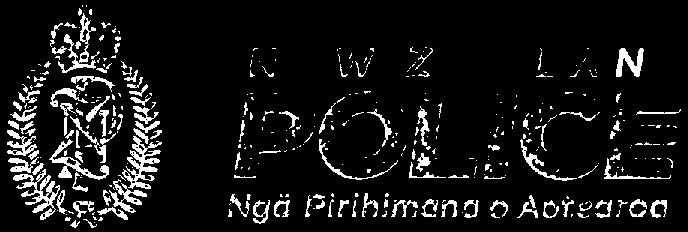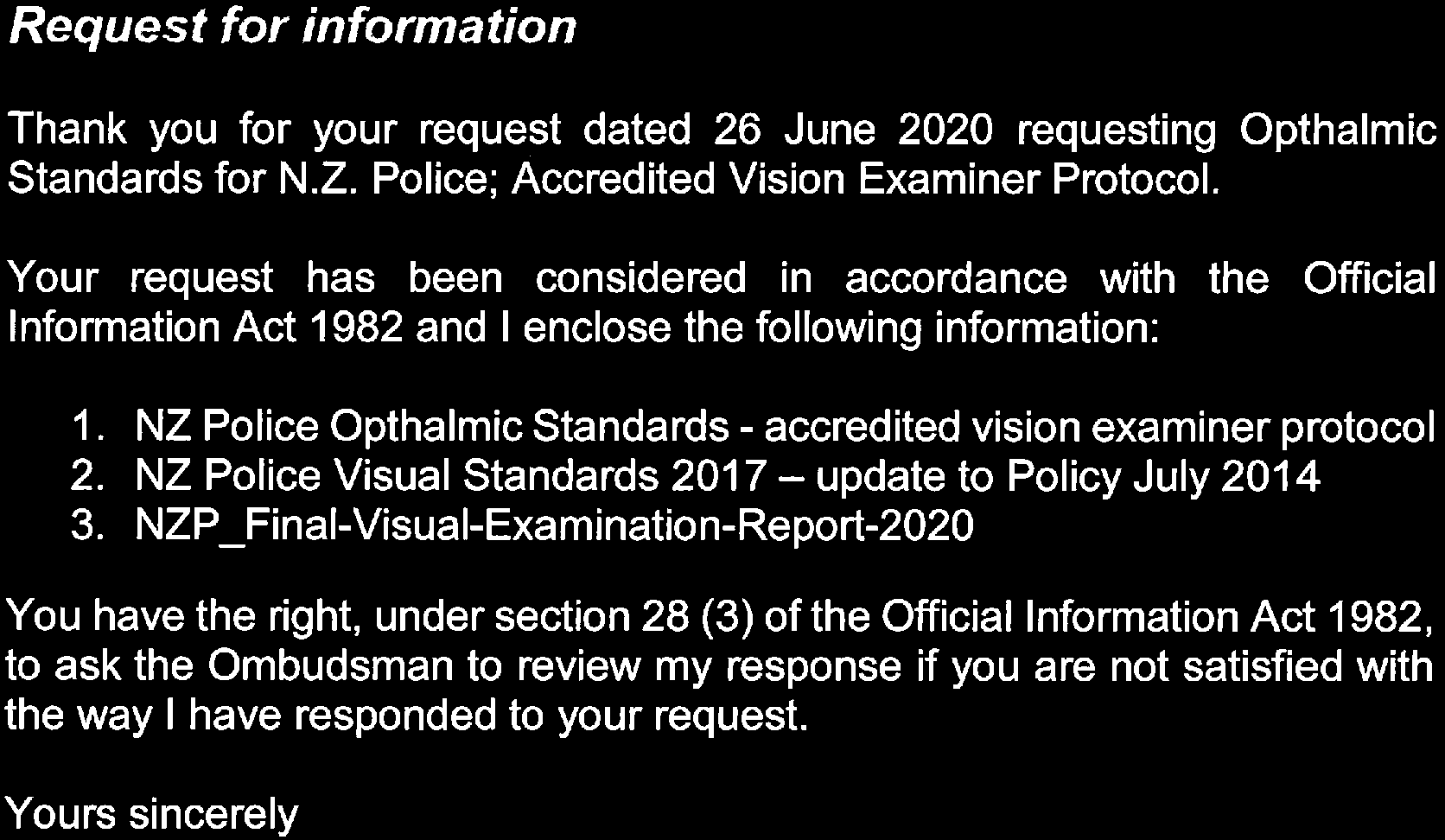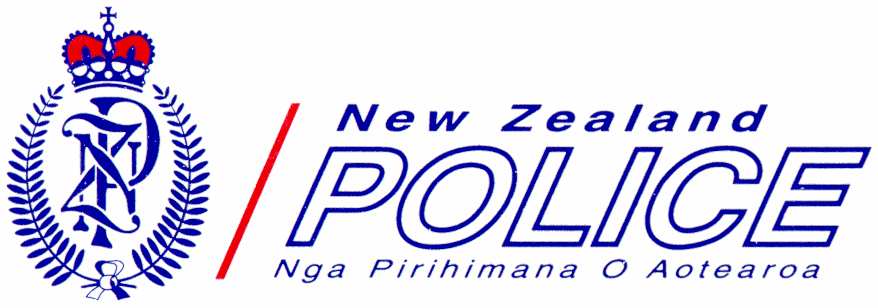





















 OPHTHALMIC STANDARDS FOR N.Z. POLICE
ACCREDITED VISION EXAMINER PROTOCOL
OPHTHALMIC STANDARDS FOR N.Z. POLICE
ACCREDITED VISION EXAMINER PROTOCOL
This Standard supercedes any previous versions:
June 2014
Accredited Vision Examiner Protocol
2
1
Introduction ___________________________________________________________________________ 3
2
Clinical Assessment _____________________________________________________________________ 3
3
Accredited Vision Examiner ______________________________________________________________ 3
4
Performance Standards Monitoring________________________________________________________ 3
5
Policy for Specified Ocular Conditions _____________________________________________________ 3
5.1. Keratotomy (R.K. & A.K.), Keratoplasty____________________________________________________________ 3
5.2
Photo Refractive Keratectomy (PRK), Laser Assisted Sub-epithelial Keratectomy (LASEK) & Laser in Situ
Keratomileusis (LASIK) ______________________________________________________________________________ 4
5.3
Glaucoma ____________________________________________________________________________________ 4
5.4
Defects in the Optical Media ______________________________________________________________________ 4
5.5
Aphakia ______________________________________________________________________________________ 5
6
Policy for Visual Aids____________________________________________________________________ 5
7
Clinical Assessment Protocol______________________________________________________________ 5
7.1 Level 1 ________________________________________________________________________________ 5
7.1.1
Vision and Visual Acuity ______________________________________________________________________ 5
7.1.2
Visual Fields________________________________________________________________________________ 6
7.1.3
Colour Perception____________________________________________________________________________ 6
7.1.4
Diplopia, Strabismus & Monocularity ____________________________________________________________ 6
7.2 Level 2 ________________________________________________________________________________ 7
7.2.1
Glare Disability _____________________________________________________________________________ 7
7.2.2
Dark Adaptation and Night Vision _______________________________________________________________ 7
7.2.3
Contrast Sensitivity Function ___________________________________________________________________ 8
8
Reporting______________________________________________________________________________ 8
Endnotes___________________________________________________________________________________ 9
Current file: Opthalmic Standards 2014 (accredited vision examiner protocol)
June 2014
Supercedes: all earlier Word docs
Accredited Vision Examiner Protocol
3
OPHTHALMIC STANDARDS FOR N.Z. POLICE
ACCREDITED VISION EXAMINER PROTOCOL
1
Introduction
Level 1 + 2, [Level 2 Accredited Vision
Police must be visually competent to drive
Examiners].
powerful vehicles safely during the day and at
night, in adverse weather and at high speeds. They
The majority of visual performance assessments
are also required to perform a range of visual tasks
will be for recruit/applicants meeting the Level 1
appropriate for their rank. To ensure that
criteria requiring equipment, which if not already
candidates and serving officers maintain a
universally available, is not expensive and is
satisfactory level of performance under marginal
easily obtained.
visual conditions, the Visual Standards for the N.Z
For the extra visual standards required for a Level
Police as detailed below will be subject to periodic
2 assessment, involving more expensive
review. They reflect the advances in clinical
diagnostic equipment, it is anticipated that
science and refractive surgery.
Examiners may be strategically located in the
main centres, and those recruit/applicants or sworn
The file name of the current standard is in the
officers requiring a Level 2 assessment, will travel
footer below - all previous versions of this
to these locations.
document should be destroyed.
All recruit/applicants and sworn officers who have
If a recruit applicant or sworn officer has
undergone corneal refractive surgery or have
undergone corneal refractive surgery they shall be
ocular pathology, must meet the visual
examined by an independent Accredited Vision
performance criteria for the Police.
Examiner, who has neither performed the surgery,
or has any commercial interest in the facilities
2
Clinical Assessment
where the refractive surgery was undertaken.
Two levels of clinical assessment are proposed;
4
Performance Standards Monitoring
Level 1 ─ for recruit/applicants who have
Should the clinical outcomes of an Accredited
not undergone corneal refractive surgery,
Vision Examiner be called into question, the
who have normal healthy eyes, &
Manager, Wellness and Safety may inspect their
Level 2 ─ for recruits who have undergone
equipment and facilities. If the unsatisfactory
corneal refractive surgery, or have ocular
performance cannot be explained, the Manager,
conditions that might compromise their
Wellness and Safety may withdraw the
visual performance and for sworn officers
accreditation of the Examiner.
whose annual performance appraisal has
raised questions about their visual status.
5
Policy for Specified Ocular
Conditions
3
Accredited Vision Examiner
Recruit/applicants
with the following specified
Accredited Vision Examiners [AVE’s] are
ocular conditions will NOT meet the entry criteria
selected from ophthalmic practitioners who
for the N.Z. Police:
undertake to perform the range of visual
5.1. Keratotomy (R.K. & A.K.),
examination procedures specified in this protocol,
& Keratoplasty
utilising the specified test equipment.
The criteria for recruit/applicants are NOT met if
Accredited Vision Examiners enter into a contract
they have undergone:
to perform visual examinations at Level 1 only
a) radial or astigmatic keratotomy
[Level 1 Accredited Vision Examiners], or for
b) keratoplasty
Current file: Opthalmic Standards 2014 (accredited vision examiner protocol)
June 2014
Supercedes: all earlier Word docs
Accredited Vision Examiner Protocol
4
c) less than three months has elapsed from
Sworn Officers
the date of the primary PRK, LASEK or
Sworn officers who have undergone keratoplasty
LASIK treatment, or from the date of any
or radial or astigmatic keratotomy, shall be
subsequent re-treatment
identified and assessed as set down in Secs 3.1,
d) they have undergone any alternative
3.4, 3.5, 3.6, 3.7 & 3.8 of the standards document
corneal refractive surgery other than
- Rationale & References, to determine that they
PRK, LASEK or LASIK, or any procedure
are visually competent to drive Police vehicles
intended to permanently modify the
and perform the range of duties required of their
corneal shape for the purposes of
rank. Reassessment of their visual fitness shall
correcting a refractive error and less than
be required at regular intervals as indicated by
one year has elapsed from the date of that
the rate of deterioration of the condition.
procedure, or any subsequent re-
treatment.
5.2 Photo Refractive Keratectomy (PRK),
e) they cannot achieve the visual standards
Laser Assisted Sub-epithelial Keratectomy
detailed in Level 1 + 2.
(LASEK) & Laser in Situ Keratomileusis
(LASIK)
Sworn Officers
Before undertaking a visual examination for the
Sworn Officers who have undergone RK PRK,
NZ Police, the AVE must be satisfied that the
LASEK, or LASIK, [or any alternative corneal
candidate meets the pre-conditions of Criteria 5.2.
refractive surgery] shall be identified and
a, b, c, & d, set out below.
assessed as set down in Secs 3.1, 3.4, 3.5, 3.6, 3.7
& 3.8 of the standards document - Rationale &
Criteria for 5.2
References, to determine that they are visually
competent to drive Police vehicles and perform
The criteria for recruit/applicants are NOT met if:
the range of duties required of their rank.
a) - there is evidence in either eye of:
- myopic retinopathy/maculopathy,
5.3 Glaucoma
- posterior staphyloma
The criteria for recruit applicants are NOT met:
- retinal tears or holes,
a) if an applicant with glaucoma is unable to
- retinal degenerations predisposing the
eye to retinal tears or holes,
Sworn Officers
- vitreoretinal traction or acute PVD, or
- retinal detachment,
Sworn officers with defects in the optical media
shall be assessed as set down in Secs 3.1, 3.4, 3.5,
b) there is a history of photo-coagulation or
3.6, 3.7 & 3.8 of the standards document -
cryotherapy to treat retinal tears, holes,
Rationale & References, to determine that they are
or to reattach the retina
visually competent to drive Police vehicles and
perform the range of duties required of their rank.
meet any of the visual standards detailed in
Level 1 + 2.
5.4 Defects in the Optical Media
The criteria for recruit/applicants are NOT met:
a) if an applicant exhibiting defect/s of the
optical media, fails to meet the criteria
detailed below for vision and visual acuity,
Current file: Opthalmic Standards 2014 (accredited vision examiner protocol)
June 2014
Supercedes: all earlier Word docs
Accredited Vision Examiner Protocol
5
low luminance visual acuity, plus the
The clinical assessments will involve the use of
standards detailed in Level 2.
equipment not necessarily found in every Practice,
5.5 Aphakia
The criteria for recruit/applicants are NOT met
but adhering to the protocol should result in
a) if an applicant is unable to read N5
uniformity and repeatability of results.
through their reading spectacles at a distance
The following visual standards shall be assessed
of 50cms.
by an Accredited Vision Examiner ─ Level 1
• vision and visual acuity
Sec 7.1.1
Sworn Officers
• visual fields
Sec 7.1.2
• colour perception
Sec 7.1.3
Sworn officers who are aphakic, but who have not
had intra ocular lens/es implanted shall be
• diplopia (binocular stability)
Sec 7.1.4
assessed as set down in Secs 3.1, 3.4, 3.5, 3.6, 3.7
• low luminance visual acuity
Sec 7.1.5
& 3.8 of the standards document - Rationale &
References, to determine that they are visually
7.1 Level 1
competent to drive Police vehicles and perform
the range of duties required of their rank.
7.1.1 Vision and Visual Acuity
Unaided vision or corrected visual acuity shall be
6
Policy for Visual Aids
measured by a logMAR high contrast chart with a
Recruit/applicants who are accepted for Police
luminance in the range of 85 to 100cd/m2
training and require visual aids are recommended
[external illumination of about 300lux.]
to use either hydrophilic contact lenses or
spectacles preferably fitted with polycarbonate or
Henceforth reference to:
acrylic lenses, or alternatively with chemically or
•
vision implies unaided vision, &
heat toughened glass lenses.
•
visual acuity implies corrected visual acuity.
Vacuum coated or photochromatic glass
Note: Vision and Visual Acuity shall be
sunglasses [prescription or plano], shall be
determined with the lids in a relaxed state.
chemically toughened, or if dyed [acrylic lenses],
shall be brown or grey tinted. The tinted lenses
The measurement of Vision and Visual Acuity has
shall have a luminous transmittance of not less
an inherent uncertainty of approximately +/-3
than 25%.
letters on a Bailey-Lovie chart. Accredited
Assessors may exercise their professional
Sworn officers are not permitted to wear mirrored
judgement as to whether or not a candidate
lenses.
achieves a pass or fail, if their results fall within
this standard deviation. This judgement shall
7
Clinical Assessment Protocol
apply to high contrast, low contrast vision and
This Clinical Assessment Protocol should be read
visual acuity, as well as to disability glare and low
in conjunction with the background document:
luminance visual acuity.
‘Ophthalmic Standards for N.Z. Police - Rationale
Criteria
and References’.
Accredited Vision Examiners will be expected to
The criteria for recruit/applicants are NOT met:
carry out a visual examination of a
a)
if an applicant makes more than two
recruit/applicant utilising their normal clinical
errors in the 6/12 [logMAR 0.3] line with
routine, but they will be required to assess the
each eye uncorrected, [VAR < than 83],
visual standards for the N.Z. Police, utilising the
b)
if an applicant makes more than two
protocol specified in this document.
errors in the 6/6 [logMAR 0.0] line with
each eye corrected,. [VAR <
than 98].
Current file: Opthalmic Standards 2014 (accredited vision examiner protocol)
June 2014
Supercedes: all earlier Word docs
Accredited Vision Examiner Protocol
6
Sworn Officers
7.1.3 Colour Perception
Sworn officers are expected to maintain their
Criteria
visual acuity to the level at which they make no
Colour vision shall initially be assessed with the
more than two errors in the 6/9 line. [VAR < than
24 plate edition of the pseudo-isochromatic
88] Sworn officers will not have their vision
Ishihara Test in daylight or artificially illuminated
routinely examined. However if their visual
with Illuminant ‘D65’. Where three or more
performance is questioned while undergoing a
errors are made on plates 2 to 17, further
performance appraisal, they may be required to
assessment is required. This shall be by a
undergo an assessment as set down in Secs 3.1,
diagnostic colour perception test such as the 100
3.5, 3.6, 3.7& 3.8 of the standards document -
Hue, D15 or a Farnsworth Lantern, and confirmed
Rationale & References, to determine that they are
with either the Medmont C100 or Oscar Colour
visually competent to drive Police vehicles and
Vision Tester.
perform the range of duties required of their rank
The criteria for recruit/applicants are NOT met if
Payment for visual aids to maintain visual acuity
either the:
is the responsibility of the Police officer
a) 100Hue, D15 or the Farnsworth Lantern
7.1.2 Visual Fields
is failed, or
Visual fields shall initially be assessed by
b) recruit/applicant is a protan.
confrontation. Perimetry shall be performed to
[A protanomalous recruit applicant may appeal,
quantify any defect detected by confrontation.
and if passed using the Holmes Wright lantern -
Visual fields shall be assessed when there is
small apertures, they shall meet the criteria.]
evidence of pathology in the retina or ocular
pathway.
7.1.4 Diplopia, Strabismus & Monocularity
Criteria
Criteria
The criteria for recruit/applicants are NOT met if
The criteria for recruit/applicants are NOT met if
an applicant has:
the applicant has:
a) monocular vision, any abnormality of
a) diplopia from whatever cause, whether
visual fields to confrontation, bitemporal
persistent or recurrent,
or homonymous hemianopia.
b) a manifest strabismus which is
b) less than 140o of horizontal field or a
cosmetically noticeable, or
vertical field of less than +/- 450 above and
c) anatomical monocularity.
below the midline.
c) a central or paracentral, relative or
Sworn officers
absolute scotoma likely to compromise
Sworn officers will not have their vision
visual performance under mesopic
routinely tested for diplopia, but if their visual
luminances, resulting in prolonged glare
performance is questioned because of diplopia,
recovery or constituting a handicap for
they may be required to undergo an
driving.
examination to ensure that they are visually
Sworn officers
competent to drive Police vehicles and perform
the range of duties required of their rank.
If the adequacy of a visual field of a sworn officer
is questioned while undergoing a performance
appraisal, they may be required to undergo visual
field testing as above, to determine that they are
visually competent to drive Police vehicles and
perform the range of duties required of their rank.
Current file: Opthalmic Standards 2014 (accredited vision examiner protocol)
June 2014
Supercedes: all earlier Word docs
Accredited Vision Examiner Protocol
7
Sworn Officers
the following additional assessments shall be
Sworn officers who have undergone PRK, LASEK,
performed by an Accredited Vision Examiner ─
LASIK, [or any alternative corneal refractive
Level 2:
surgery], have been affected by glaucoma, or have
cataracts, shall be assessed as set down in Secs
• glare disability
Sec. 7.2.1
3.1, 3.5, 3.6, 3.7 & 3.8 of the standards document
• dark adaptation
Sec. 7.2.2
- Rationale & References, to determine that they
• contrast sensitivity
Sec. 7.2.3
are visually competent to drive Police Vehicles
and perform the duties required of their rank.
7.2.1 Glare Disability
Criteria
7.2 Level 2
The criteria for recruit/applicants are NOT met:
if the applicant viewing the high contrast
If a recruit applicant or sworn officer has:
letter chart while in the presence of the glare
• undergone PRK, LASEK, LASIK,
[or any
source, produced by either the:
alternative corneal refractive surgical
a)
BEGAT with the glare level set at the
procedure currently available or any that
HIGH setting,
may be developed in the future],
b) Brightness Acuity Tester (BAT) with the
• defects in the optical media
glare level set at the MEDIUM setting, or
• glaucoma,
c) Brightness Acuity Tester (MARCO BAT
1000) with the glare level set at the
MEDIUM setting, & has a high contrast
visual acuity in either eye, that is worse
than 6/7.5,< logMAR 0.1, or < VAR = 95]
i
7.2.2 Dark Adaptation and Night Vision
Criteria
The criteria for recruit/applicants are NOT met:
if there is retinal pathology or a congenital
abnormality present or is a history of familial
retinal disease (such as retinitis pigmentosa).
Candidates shall be referred to an approved
specialist for assessment for the prognosis of
the disease and the implications for the
maintenance of visual standards.
Sworn officers
Sworn officers with retinitis pigmentosa,
glaucoma and choroido retinitis shall be assessed
as set down in Secs 3.1, 3.5, 3.6, 3.7 & 3.8 of the
standards document - Rationale & References, to
determine that they are visually competent to drive
Police vehicles and perform the duties required of
their rank.
Current file: Opthalmic Standards 2014 (accredited vision examiner protocol)
June 2014
Supercedes: all earlier Word docs
Accredited Vision Examiner Protocol
8
8 Reporting
7.2.3 Contrast Sensitivity Function
The result of the vision assessment of a
To achieve a rapid and adequate estimation of the
applicant/recruit or sworn officer shall be reported
overall nature of the contrast sensitivity function,
on the form:
two measurements shall be made for each eye:
‘Visual Examination Report – Ophthalmic
1) low contrast [10% contrast] visual acuity, &
Standards for the N.Z. Police’.
2) the contrast threshold for an “edge” stimulus
The Visual Examination Report shall then be
utilising either the:
forwarded to the:
a) original hand held Melbourne Edge Test
(MET), evenly illuminated between 18 and
Medical Clearance Co-ordinator
85 cd/sq-m and held between 40 & 50cm,
b) BEGAT version of the Melbourne Edge
Attention: Briar Campbell
Test (MET) test internally illuminated at
Level One - Recruiting
310 cd/sq-m and scaled for a working
Police National Headquarters
distance of 100cm, or ii
P.O. Box 3017
c) NVRI version of the Melbourne Edge Test
WELLINGTON 6140
(MET) test internally illuminated with a
battery powered light box.
Criteria
The criteria are NOT met if a recruit/applicant:
a) has a low contrast visual acuity in either
eye, that is worse than 6/9, < logMAR 0.2, or
< VAR = 90], &
b) when assessed on the MET, has a contrast
threshold < 17.0dB in either eye. [ = to an
edge contrast sensitivity of 70] ( 95%
confidence level ) iii
Current file: Opthalmic Standards 2014 (accredited vision examiner protocol)
June 2014
Supercedes: all earlier Word docs
Accredited Vision Examiner Protocol
9
Endnotes
3) Jacobs RJ, Hendicott PL, Murphy B,
Poppelwell D, Turner PJ. “Visual performance
requirements for post-PRK police recruits” Clin.
i Elliott & Bullimore (1993) 2) show that, on the average, the
& Exp. Optom, 1998;81:163-173
addition of medium glare from the BAT:
4) Kreuger RR et al. “Clinical analysis of excimer
I. made NO difference to the acuity of young
normal subjects (24yrs +/- 3.3 yrs) and
laser photorefractive keratectomy using a multiple
II. induced a 3 to 4 letter reduction to the acuity of
zone technique for severe myopia” Amer J of
older normal subjects (66yrs +/- 6 years).
Ophthal Mar 1995;119:263-275
As the standard deviation for measurements with or without
glare was the same +/- 3 to 5 letters on the Bailey Lovie
5) Maguire LJ & Bechara S “Epithelial
chart, the 95% confidence interval for change would be an
distortions at the ablation zone margin after
acuity reduction of less than 6 to 8 letters.
excimer laser photorefractive keratectomy for
In summary, these data state that there should essentially be
myopia” Letters to the Journal Amer J of Ophthal
no change in acuity for young subjects when subjected to
Jun 1995 1995;117:809-810.
glare. However as the measurement of acuity is imprecise,
and for a 95% certainty of a change due to glare, a loss of 6
6) “Medical Examinations of Commercial
to 8 letters of acuity is allowed.
Vehicle Drivers” Prepared for the: National Road
Bailey & Bullimore (1991) 1) reported results from the
Transport Commission and the Federal Office of
Berkeley (surround) glare tester. Their study supported
Road Safety, by the Australasian Faculty of
previous work which demonstrated that susceptibility to
Occupational Medicine. Nov 1995 ISBN 0 652
disability glare increases with age and that the test is
21209 0
sensitive to relatively subtle changes in nuclear sclerosis or
corneal edema.
7) Verbaken JH & Johnston AW “Population
norms for edge contrast sensitivity” Amer J
ii Woods & Wood (1995) 8) determined that the average
Optom & Physiol Optics 1986;63:725-732.
monocular score for a MET chart, evenly illuminated
between 18 and 85 cd/sq m, viewed at between 40cm &
8) Woods RL & Wood JM “The role of contrast
57cm, by persons of an average age of 50yrs, was 20.5dB.
sensitivity charts and contrast letter charts in
They noted that there is little correlation between age and the
MET result.
clinical practice”. Clinical and Experimental
Optometry 1995; 78: (2) 53-57.
iii Verbaken & Johnston (1986) 7) indicated that the standard
deviation for a clinical population would be about +/- 1.5dB
to +/- 2.0dB [Note: converting from their formula of:
dB = -20 x log(contrast)
to the one used for decibels in the MET:
dB = -10 x log(contrast)
Therefore a significant (to the 95% level) departure from the
normal (in the worsening direction) would be between 20.5 -
3.00 = 17.5dB and 20.5 - 4.00 = 16.5db.
10 References
1) Bailey IL, Bullimore MA. “A New Test for the
Evaluation of Disability Glare” Optometry &
Visual Science Vol.68, No.12, pp911-917
2) Elliott DB & Bullimore MA “Assessing the
reliability, discriminative ability and validity of
disability glare tests” Invest Opthal & Vis Sci
1993;35:108-119
Current file: Opthalmic Standards 2014 (accredited vision examiner protocol)
June 2014
Supercedes: all earlier Word docs
NZ Police Visual Standards – update to Policy July 2014
Please note the fol owing changes to the NZ Police Ophthalmic Standards:
1. Low luminance is no longer being tested.
2. An ophthalmological certificate is no longer required post corneal refractory surgery.
3. Binocular vision is now requested and taken into account with borderline pass/fail.
4. A note to ensure that a level I & II examination is required for all applications with a
history of corneal refractory surgery 3 months post procedure OR a level I
examination with a report from eye surgeon confirming nil issues post operatively.
5. A request that optometrists do NOT retain copies of NZ Police visual documentation –
these are dynamic in nature and subject to regular review, as such from 1st July only
new NZ Police Visual paperwork (as attached) will be accepted.

 Final Visual Examination Report
Information for Applicants
Final Visual Examination Report
Information for Applicants
This report is to be completed by a NZ Police approved optometrist. Please then return this questionnaire (pages 1-3) either by
scanning and emailing t
o [email address], or sending the report to:
Medical Recruitment Team
Royal New Zealand Police Col ege
Private Bag 50906
Porirua 5024
Police pay for this “Final Visual Examination” only.
IMPORTANT: There wil be no guarantee of payment for additional tests or investigations without NZ Police’s authority. There is
currently nil requirement for OCT as part of a routine eye examination for new recruit applicants. Any additional investigations wil be at
the applicant’s expense.
Please get your Optometrist to ensure that
the invoice includes the cost centre number 70758, is made out to
"NZ Police (New Recruit)", and returned to
Shared Services, PO Box 2797, Wellington 6140.
For any invoicing queries please contact the NZ Police accounts team directly at [email address] or
04 238 6710 ext. 43710.
The information collected from you on this Visual Examination Report is required by NZ Police for the purpose of assessing your
suitability to join NZ Police as a recruit. If you are selected as a recruit, this information wil be retained on your medical file and may be
used and/or disclosed for the purpose of ensuring you maintain your health while an employee of NZ Police.
PERSONAL DETAILS
Family name
First names
Address
Home phone
Mobile phone
Date of birth
Email address
MEDICAL INFORMATION
1. Are any of the fol owing ocular conditions present:
1.1 Keratotomy - Radial (R.K), or Astigmatic (A.K), Keratoconus or Keratoplasty
1.1.1 Keratotomy (R.K., or A.K)
Yes
Fail
No
Pass
1.1.2 Keratoconus
Yes
Fail
No
Pass
1.1.3 Keratoplasty
Yes
Fail
No
Pass
PASS
1.2
PRK, LASEK, LASIK, or alternative corneal refractive procedure
1.2.1 Any corneal refractive procedure
Yes
No
Go to 1.2.2
Go to 1.3
1.2.2 Has at least 3 months elapsed from a PRK, LASEK, LASIK treatment or re-treatment?
Yes
No
Date:
Do not proceed
1.3
Glaucoma
Yes
Fail
No
Pass
Final V isual Examination Report | 23 July 2019
1 of 3

 1.4
Defects in the Optical media
Yes
Fail
No
Pass
1.5
Aphakia
Yes
Fail
No
Pass
1.4
Defects in the Optical media
Yes
Fail
No
Pass
1.5
Aphakia
Yes
Fail
No
Pass
Note: IOLs must be implanted in both eyes to pass.
Go to 1.5.1
Go to 2
1.5.1 Any corneal refractive procedure
R.E.
IOL
L.E.
IOL
LEVEL 1 ASSESSMENT
2. Vision and visual acuity
2.1
Uncorrected vision
R.E. 6/ +/- letters
L.E. 6/ +/- letters
2.2
Uncorrected binocular vision
Fail if worse than 6/12 (logMAR 0.3) - 2 letters = VAR< 83.
2.3
Corrected vision
R.E. 6/ +/- letters
Fail if worse than 6/6 (logMar 0.0) - 2 letters, CAR<98 in either eye.
L.E. 6/ +/- letters
PASS
3. Visual fields
3.1
Monocular vision
Yes
Fail
No
Pass
3.2
Abnormal fields to confrontation
Yes
Fail
No
Pass
3.3
Bitemporal or homonymous hemianopia
Yes
Fail
No
Pass
3.4
<140°
horizontal & +/- 45°
vertical field
Yes
Fail
No
Pass
4. Colour perceptions
4.1
Ishihara
Fail
Pass
4.2
Other diagnostic colour perception test e.g. D15, D15 saturated, CAD
Fail
Pass
4.3
Medmont C100 or Oscar colour vision tester
Fail
Pass
PASS
5. Diplopia and Strabismus
5.1
Diplopia or manifest strabismus present
Yes
Fail No
Pass
LEVEL 2 ASSESSMENT *only to be completed if history of visual corrective surgery
6. Glare disability
Fail if worse than 6/7.5 (logMAR = 0.1), VAR<95 in either eye
R.E. 6/ +/- letters
L.E. 6/ +/- letters
Final Visual Examination Report | 23 July 2019
2 of 3

 7. Dark adaption and night vision
7.1 Any history of familial/retinal disease present
Yes
Fail No
Pass
8. Contrast sensitivity function
8.1 Low contrast acuity
Fail
Pas
Fail if worse than 6/9 (logMAR = 0.2) VAR<90 in either eye.
8.2 Met edge contrast threshold
Fail
Pas
Fail <17.00db = edge contrast sensitivity of 70 in either eye
7. Dark adaption and night vision
7.1 Any history of familial/retinal disease present
Yes
Fail No
Pass
8. Contrast sensitivity function
8.1 Low contrast acuity
Fail
Pas
Fail if worse than 6/9 (logMAR = 0.2) VAR<90 in either eye.
8.2 Met edge contrast threshold
Fail
Pas
Fail <17.00db = edge contrast sensitivity of 70 in either eye
9. Outcome of this examination
FAIL
PASS
10. Recommendations
Examiner’s name
Address (stamp)
Date
Examiner’s signature
I consent to this visual examination and the release of the results to:
Medical Recruitment Team
Royal New Zealand Police Col ege
Private Bag 50906
Porirua 5024
Applicant’s name
Date
Applicant’s signature
Final Visual Examination Report | 23 July 2019
3 of 3
Document Outline




























